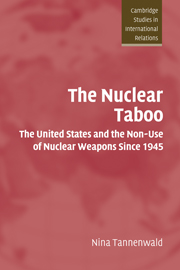Book contents
- Frontmatter
- Contents
- Preface
- List of abbreviations
- 1 Introduction: the tradition of nuclear non-use
- 2 Explaining non-use
- 3 Hiroshima and the origins of the nuclear taboo
- 4 The Korean War: the emerging taboo
- 5 The rise of the nuclear taboo, 1953–1960
- 6 Nuclear weapons and the Vietnam War
- 7 Institutionalizing the taboo, 1960–1989
- 8 The 1991 Gulf War
- 9 The taboo in the post-Cold War world
- 10 Conclusion: the prospects for the nuclear taboo
- Select bibliography
- Index
- CAMBRIDGE STUDIES IN INTERNATIONAL RELATIONS
1 - Introduction: the tradition of nuclear non-use
Published online by Cambridge University Press: 22 September 2009
- Frontmatter
- Contents
- Preface
- List of abbreviations
- 1 Introduction: the tradition of nuclear non-use
- 2 Explaining non-use
- 3 Hiroshima and the origins of the nuclear taboo
- 4 The Korean War: the emerging taboo
- 5 The rise of the nuclear taboo, 1953–1960
- 6 Nuclear weapons and the Vietnam War
- 7 Institutionalizing the taboo, 1960–1989
- 8 The 1991 Gulf War
- 9 The taboo in the post-Cold War world
- 10 Conclusion: the prospects for the nuclear taboo
- Select bibliography
- Index
- CAMBRIDGE STUDIES IN INTERNATIONAL RELATIONS
Summary
Within, at the most, ten years, some of those [nuclear] bombs are going off. I am saying this as responsibly as I can. That is the certainty.
C. P. Snow, 1960Who could have believed fifty years ago that a new century would arrive – a new millennium – without any nuclear weapons being fired at a target? … Something quite unanticipated happened. Rather, something widely expected didn't happen.
Thomas C. Schelling, 2002More than sixty years have passed since the American use of atomic bombs on Hiroshima and Nagasaki, the only use of nuclear weapons in warfare. The non-use of nuclear weapons since then remains the single most important phenomenon of the nuclear age. Yet we lack a full understanding of how this situation arose and is maintained, and of its prospects for the future. As military historians have noted, it is rare for a weapon found useful on one occasion to remain unused in the next. Such an outcome was not inevitable. At the height of the nuclear arms race in the 1980s, nearly 70,000 nuclear weapons existed in the world's nuclear arsenals. In addition, an extensive array of military plans and organizations, national policies, public commitments, and alliances all contemplated the employment of such weapons. Many reasonable observers expected that nuclear weapons would be used at some point during the Cold War. It was thus by no means inevitable that, after their use against Japan in August 1945, a “tradition” of non-use would arise.
- Type
- Chapter
- Information
- The Nuclear TabooThe United States and the Non-Use of Nuclear Weapons Since 1945, pp. 1 - 28Publisher: Cambridge University PressPrint publication year: 2007

